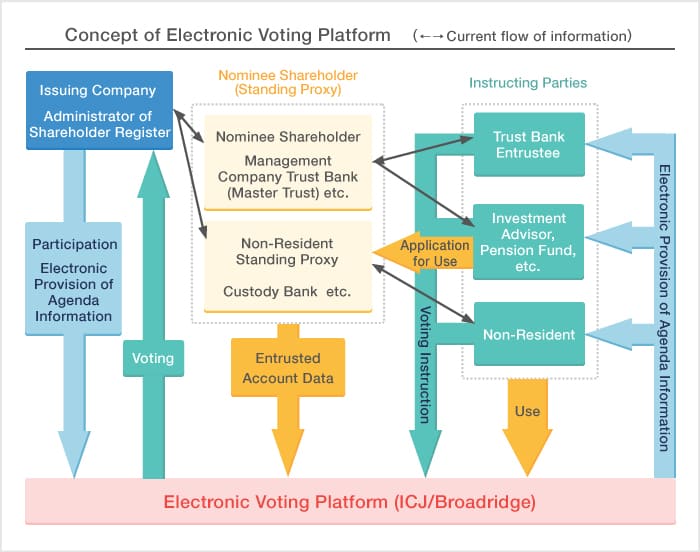Electronic Voting Platform, etc.
Information Flows on the Platform

The following explains the flow of information on the platform according to the "Conceptual Diagram of the Platform" shown above.
The first step is the flow of agenda information from the issuer to the instructing parties. First, the issuer registers the convocation notice information via TDnet. Upon receiving this information, the platform will classify agenda items based on codes for the predetermined classification for each agenda item of the general meeting, and post it on the platform's website along with the PDF file on the date of dispatch of the convocation notice. The instructing parties will be able to view this information directly.
The agenda information registered on the platform will be provided to the instructing parties as of the record date who have a contractual relationship with the nominee shareholders/standing proxies, but the original data, the account information (number of shares held, etc.) of the instructing parties, will be provided to the platform by the respective nominee shareholders/standing proxies.
Each instructing party will view the proposal information, examine its contents, and then instruct the platform system to vote for the proposal. The exercise information entered by each instructing party is fed back to the Transfer Agent who is directly engaged in the counting of votes through the platform, and the information is fed back with the ID/PW of the nominee shareholder to whom each instructing party is reliant on (only as part of the exercise of voting rights by the nominee shareholder).
Contractual Relationships, etc.
The platform is not operated based on newly established laws, regulations, etc. It is operated based on contracts between each party.
- First, the issuer will enter into a contract with ICJ, Inc. for participation. Since the exercise of voting rights through the platform is also part of the electronic voting system under the Company Act, participating in the platform means adopting the electronic voting system.
- Trust banks and custodian banks, as nominee shareholders/standing proxies, will also enter into contracts with ICJ, Inc. This contract will be an outsourcing agreement or business commissioning contract for voting-related matters from the nominee shareholders/standing proxies to ICJ, Inc. Based on this contract, ICJ, Inc. will act as the representative and assistant to the registered shareholders in carrying out voting-related tasks. (Under the Company Act, only shareholders listed in the shareholder registry are allowed to exercise voting rights, and in the platform utilization scheme, it is still the registered shareholders who exercise the voting rights, while ICJ, Inc. acts as the "representative" and "assistant" entrusted with the tasks by the nominee shareholders/standing proxies, enabling them to operate within the framework of the Company Act.)
- The instructing parties will also enter into contractual relationships as users of the platform. Based on the contracts with the nominee shareholders/standing proxies, the platform terms of use (contract) applicable to the instructing parties, who are clients of the nominee shareholders/standing proxies, will be established, and they will be required to adhere to those terms.
System Safety
The connection method between Transfer Agent, trustee banks, and Standing Proxy with the platform often involves using dedicated lines or backup lines. It connects to the file relay server in the U.S. data center via the access point in the domestic data center of the platform, and performs file transmission. The data handled by the platform is highly confidential, so high-security applications and communication protocols are used as measures against interception and tampering of the content.
In addition, since extremely high fault tolerance is required, the core system and peripheral devices are constructed in a multiply-redundant configuration. Broadridge's data center, where the core system is located, is multiplexed with backup sites in remote locations, and is centrally managed with a thorough system monitoring system to ensure a quick response in the event of a large-scale disaster or failure.
Broadridge's data center has received a Tier 4 rating, the highest standard for availability, from The Uptime Institute, a U.S. professional evaluation organization, as proof of its extremely high level of reliability.
(The rating is given to data centers that meet the highest requirements from various perspectives, from the data center‘s location, building robustness, power supply routes, power capacity, UPS (uninterruptible power supply) deployment, and staffing, and has a probability of 99.995% or higher of continuous operation without system downtime for five years.)



